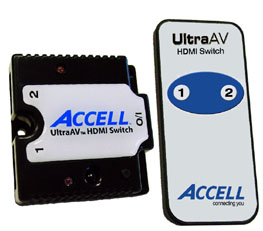|
|
||||
Fortunately, HDMI switchers are becoming common, either as units built into your A/V receiver/preamp/processor directly or free standing. In the former case that could mean investing in a new component, which isn't cheap at this point in time; in the latter case of a freestanding switcher, it means one more component in your stack of stuff.
Then there's Accell's UltraAV HDMI 1.3 Audio and Video 2-1 Switch, a tiny little critter you can tuck out of the way, but which will let you switch two HDMI inputs into a single output. It even comes with a tiny remote control befitting the diminutive size of the switcher.
This $100 unit is about two inches square and half an inch high and has mounting holes in it so you can screw it to the wall or shelf. The front panel has an LED to indicate which input you're using (you can also look at your TV to see which signal's coming through!) and the unit will pass signals right up to 1440p (and multichannel audio) with no problem.
Of course mounting the thing on the wall behind your technological toys may mean it'll be out of the way of the infrared remote's signals. But fear not! Accell has taken care of this by including a little IR extender, a five foot cable with a remote IR sensor on the end that you can stick in front of your equipment (where it'll take up hardly any room at all). It's an elegantly simple solution.
Not only that, but no external power is required, so you won't take up another electrical outlet with it.
 Out of the box, the Accell is virtually obsolescence proof, at least for the next few years. It's HDMI 1.3a Category 2 compliant, which is farther along the technological ladder than most products on the market today (HDMI 1.2 is more common), and it's backward compatible so today's HDMI stuff will work with it. Accell says HDMI 1.3 "more than doubles HDMI’s previous bandwidth and adds support for Deep Color technology and new high-definition (HD) digital audio formats."
Out of the box, the Accell is virtually obsolescence proof, at least for the next few years. It's HDMI 1.3a Category 2 compliant, which is farther along the technological ladder than most products on the market today (HDMI 1.2 is more common), and it's backward compatible so today's HDMI stuff will work with it. Accell says HDMI 1.3 "more than doubles HDMI’s previous bandwidth and adds support for Deep Color technology and new high-definition (HD) digital audio formats."
The remote control is a model of simplicity: you just press button 1 or button 2 and that's it.
In my viewing tests with the unit, I noticed no drop off in video quality (I didn't try it with high definition audio signals), which is exactly what you want: the switcher's presence should be as invisible to your video screen (and your eyes) as this one's tiny size makes it in your equipment stack. And it is.
The only real downside is that if you have more than two HDMI sources you're out of luck, but two inputs should be plenty for a lot of people for the next few years.
Jim Bray's columns are available through the TechnoFile Syndicate.

 HDMI Switcher Accells in Home Theater Setting
HDMI Switcher Accells in Home Theater Setting